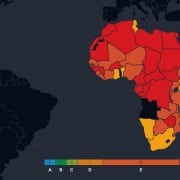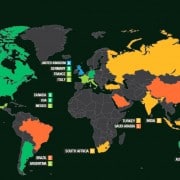|
Getting your Trinity Audio player ready...
|
Image: Wikimedia Commons, used under a Creative Commons Attribution-Share Alike 3.0 Unported license.
Transparency International Defence & Security has released the latest edition of its government defence integrity (GDI) index. The 2020 edition is now available online. It was previously known as the Government Defence Anti-Corruption Index.
Corruption in the defence sector weakens public institutions and also limits a country’s ability to defend itself. Government bodies play a pivotal role in preventing the waste of public funds, the abuse of power, and corruption in the defence and security sector, says TI.
The GDI assesses corruption risks in government defence institutions by examining the existence, effectiveness, and enforcement of institutional controls across five key corruption risk areas – they are political, personnel, procurement, financial, and operational risk. The GDI also assesses both legal frameworks (de jure) and implementation (de facto), as well as resources and outcomes in some areas, so as to capture the implementation gap between law and practice, and possible areas for reform to narrow that gap.
Almost 90 countries went under the microscope for the 2020 edition. The indes uses 77 questions or indicators to produce a score between 0-100, with 0-16 (the F band) indicating a critical risk of defence corruption, and 83-100 (the A band) indicating a very low risk of corruption.
The GDI, says TI, is a useful tool for civil society to collaborate with defence ministries, as well as military and oversight institutions, to build their capacity in terms of improving transparency and integrity.
Download the South Africa country brief.
Download the South Africa scorecard.
South Africa better than last time, but still no shining light
In the previous edition (2015) South Africa was placed in band D, which put it not only in the lower half of all countries assessed but also in the high-risk category for corruption in the defence and security sector.
It fared slightly better this time around, scoring 57/100 overall and achieving a final placement in the C band, indicating moderate risk. This puts it in the same band as Denmark, Australia, Canada, Japan, and Sweden, among others. Of the 77 indicators on which it was scored, 17 were in the A band, 14 in the B band, 17 in the C band, seven in the D band, eight in the E band, and five in the F band. The final nine indicators ended up in the Not Applicable, Not Scored or Not Enough Information band.
Furthermore, South Africa is not one of the 62% of countries that this year received an overall score of 49/100 or lower. It also scored better than the G20 average of 49/100.
And it was the highest-placed country in the East and Southern African region, followed by Botswana, Kenya and Uganda in the D band, Tanzania and Zimbabwe in the E band, and South Sudan and Sudan in the F band.
Mozambique, eSwatini, Lesotho and Namibia were not assessed, while Angola (F band) is grouped with West and Central Africa.
“Institutional resilience to corruption is modest in South Africa’s defence sector,” the GDI notes. “Financial and personnel management process are relatively robust, however poor oversight of the policy-making and procurement processes, coupled with limited transparency and access to information heighten corruption risk.”
South Africa scored 76/100 for financial risk, making this its best performing and lowest risk area. Predictably, its highest risk lies in operations with a meagre 36/100, and procurement with 51/100. However, TI says, almost every country scored poorly in terms of its safeguards against corruption in military operations. “The average score in this area is just 16/100 because most countries lack anti-corruption as a core pillar of their mission planning.”








